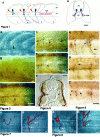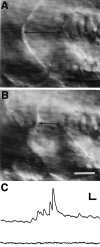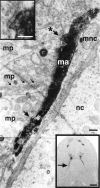Pathfinding by identified zebrafish motoneurons in the absence of muscle pioneers
- PMID: 9315900
- PMCID: PMC6793908
- DOI: 10.1523/JNEUROSCI.17-20-07796.1997
Pathfinding by identified zebrafish motoneurons in the absence of muscle pioneers
Abstract
To identify the cellular cues that guide zebrafish neuronal growth cones to their targets, we examined interactions between identified motor growth cones and identified muscle fibers and tested whether these fibers were required for growth cone navigation. Caudal primary motoneurons (CaPs) and middle primary motoneurons (MiPs) are identified motoneurons that innervate cell-specific regions of the myotome. Growth cones of both cells initially extend along a common pathway and then pause at a set of identified muscle fibers, called muscle pioneers, before diverging along cell-specific pathways. Muscle pioneers are intermediate targets of both CaP and MiP (Westerfield et al., 1986; Liu and Westerfield, 1990); both motoneurons extend their growth cones directly to the muscle pioneers on which the first functional neuromuscular contacts form, suggesting that muscle pioneers may provide guidance information to these growth cones. We tested this idea by ablating muscle pioneers and observing the resulting motor axonal trajectories. Both CaP and MiP ultimately formed normal axonal arbors after muscle pioneer ablation, showing that muscle pioneers are unnecessary for formation of correct axonal trajectories; however, although final cellular morphology was correct in the absence of muscle pioneers, MiP growth cones branched abnormally or extended ventrally beyond the common pathway. Ablation of CaP and the muscle pioneers together increased the aberrant behavior of the MiP growth cone. Our results provide evidence that an intermediate target, the muscle pioneers, affects motor axonal extension without altering target choice, suggesting that other cues also contribute to proper pathway navigation.
Figures




References
-
- Altman J, Bayer SA. The development of the rat spinal cord. Adv Anat Embryol Cell Biol. 1984;85:1–164. - PubMed
-
- Beattie CE, Eisen JS. Notochord alters the permissiveness of myotome for pathfinding by an identified motoneuron in embryonic zebrafish. Development. 1997;124:713–720. - PubMed
-
- Bentley D, Caudy M. Pioneer axons lose directed growth after selective killing of guidepost cells. Nature. 1983;304:62–65. - PubMed
-
- Bentley D, Keshishian H. Pathfinding by peripheral pioneer neurons in grasshoppers. Science. 1982;218:1082–1088. - PubMed
Publication types
MeSH terms
Grants and funding
LinkOut - more resources
Full Text Sources
Molecular Biology Databases
Miscellaneous
